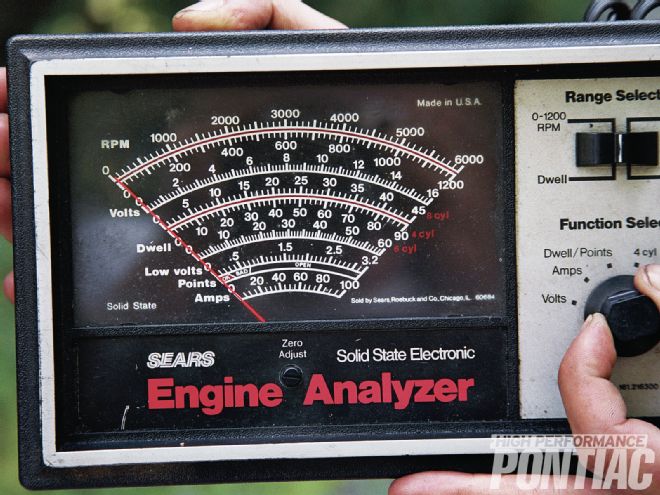
The ability to take proper measurements is required to help diagnose many conditions or problems with your Pontiac. Measuring the electrolysis of the coolant or the dwell on an HEI ignition module can assign accurate, hard numbers as to its condition and eliminate the work, embarrassment, and expense of changing parts as a diagnostic step.
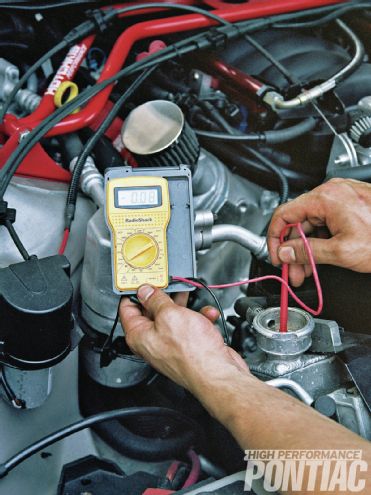
The skill of measuring is not hard to master but sometimes requires special tools, such as a dwell meter, voltmeter, or infrared thermal heat gun. The decision of which tools to invest in will have to be yours, along with learning to use them. The purpose of this primer is to show the basic steps of how to take a few pertinent measurements on a Pontiac. Hopefully, this will enable you to get to know your Pontiac better and keep it in top condition.
For our photos, we worked with Joey Jaramillo of IDA Automotive in Morganville, New Jersey.
Circuit Resistance
Tool required: Volt-ohm meter
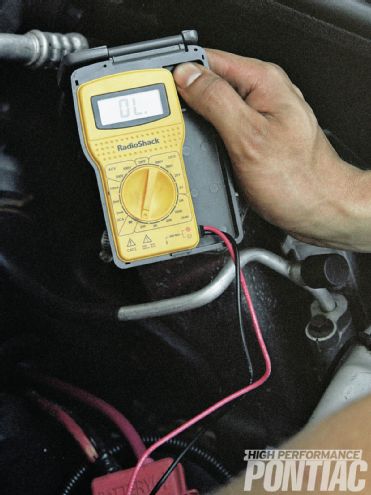
Resistance in a circuit is opposition to current flow. To check the resistance of a circuit, make sure it’s not powered and remove it from the circuit (unplug it). Place the meter on the ohm scale and connect the two leads across the circuit. An ohm meter has no polarity so it makes no difference which lead goes where. When checking a circuit for continuity, an open circuit will read infinity or over range since there is no complete path. You can use this test to check a light bulb or any other electrical part such as an ignition wire or a coil. This is a very good test for late-model Pontiacs with DIS ignition and coil packs.
Battery Condition
Tool required: Volt-ohm meter
When checking battery voltage, the meter needs to be connected in the proper polarity. A good battery when at rest will have around 12.6 volts. That is called the surface charge. As the cells begin to sulfate, the voltage at rest may actually go higher to around 13.1, but its capacity is diminished. To check a Pontiac’s battery, place the meter across the battery terminals. With the ignition disabled, have a helper crank the engine over. The battery should have enough capacity to keep the voltage above 9.6 for an extended crank of 10-15 seconds. If it does not, it’s weak and needs to be replaced before winter.
Sticking Brake Pad or Shoe vs. Frozen Caliper or Wheel Cylinder
Tool required: Infrared thermometer
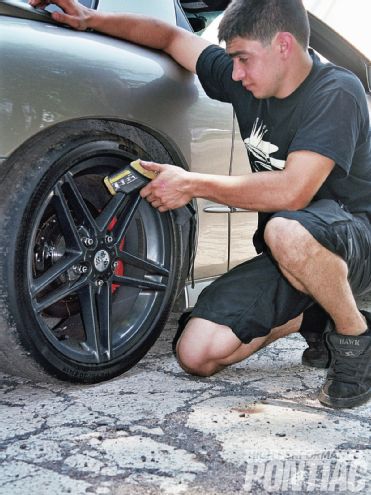
Go for a short drive at a speed above 35 mph. Gently stop the Pontiac in a safe place on the shoulder of the road or back at home. Quickly go to each wheel and through the rim (if equipped with wheel covers, they will need to be removed first) measure each disc or drum in the same spot with an infrared thermometer to measure the rotor and or drum temperature. They should be within 10 percent front to front and rear to rear.
If one is very hot, then that pad or shoe is hanging up. A very cold reading indicates the caliper or wheel cylinder may be frozen or hardly moving. Frozen rear calipers were a complaint of some owners of Second-Gens and Third-Gens equipped with rear disc brakes.
Ignition Dwell Reading for Diagnostics
Tool required: Tach/dwell meter
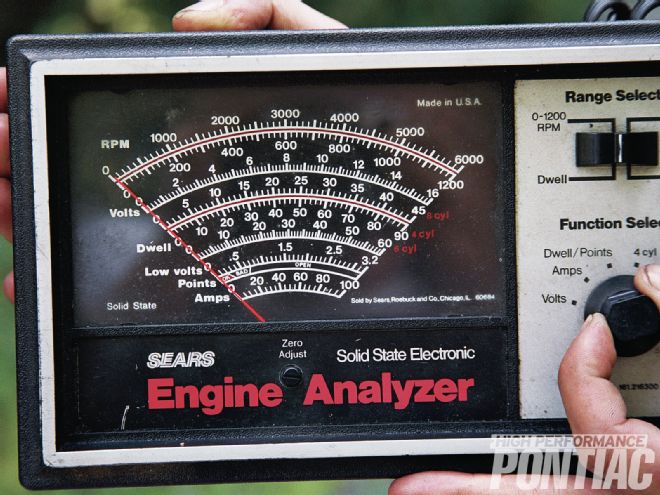
A dwell meter can be used to check the breaker points, function of an HEI module, or the mixture correction in a Rochester feedback carburetor. To check ignition dwell with either breaker points or an HEI system, hook the dwell meter to the negative side of the coil (TACH terminal on HEI) and the leads to the battery. Using the proper number of cylinders scale, start the engine and read the dwell. Increase the engine speed—the dwell with breaker points should stay the same. If not, the points are bouncing or the distributor shaft bushing is worn.
With HEI, the dwell should increase from around 10 degrees at idle to 30 degrees by 2,500 rpm on a V-8 Pontiac. If the dwell is fixed or hardly expands, the ignition module is defective even though the engine is running.
The dwell meter can also be used to check the mixture control solenoid on an electronic Rochester carburetor. For this test you must use the six-cylinder scale regardless of the engine style. Under the hood will be a green connector. Hook the dwell lead to the connector and start the engine and let it warm up so the system goes closed loop. The dwell on the mixture control solenoid should be around 30 degrees on the six-cylinder scale. If it’s less than that, the carburetor is too lean or the engine has an air leak. Higher than 30 degrees means the carburetor is too rich or there is gasoline in the engine oil.
Electrolysis in the Coolant
Tool required: Volt-ohm meter
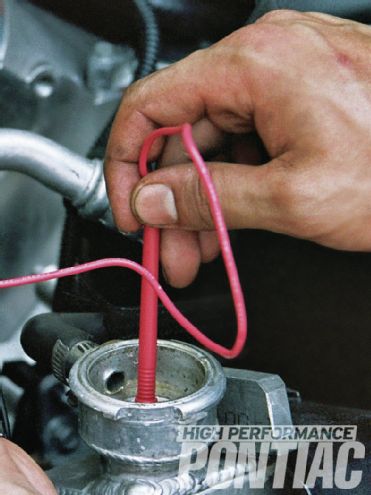
A poor electrical ground in your Pontiac can end up turning the engine’s coolant into a battery. When this occurs, the coolant becomes corrosive and will eat pinholes in the intake manifold water passages, heater core, and radiator. If bad enough, it can ruin the cylinder heads or engine block.
To check for electrolysis, remove the radiator cap with the engine cold. Then, with the engine running and all electrical accessories on, stick the meter’s positive lead into the coolant while being careful not to touch the sides of the radiator. The negative lead goes to the vehicle’s battery ground terminal. There should be no voltage.
An older Pontiac with a cast-iron block and cylinder heads and a copper/brass radiator can tolerate up to 0.2 of a volt from electrolysis. A newer model with an aluminum engine and radiator with plastic tanks cannot tolerate anything over 0.1 of a volt. Our subject Firebird was fine with only 0.08 of volt in the coolant.
The hallmark of electrolysis is small pinholes in the failed component. Another good test is to check the voltage while cranking the engine over with the ignition disabled. This will reveal a poor ground in the starting circuit. If you have experienced repeated pinhole failures then electrolysis is most likely occurring. This is very common when the vehicle has been in a bad accident and the body shop does not reconnect all of the grounds.
Proper Tire Pressure
Tool required: Tire pressure gauge, infrared thermometer
You can use a temperature gun to determine proper tire inflation for the weight of your Pontiac. First, check the tire pressure when they are as near as possible to ambient temperature. Make sure that one side of the Pontiac is not in the sun, as this will skew the reading. (Tire pressure will increase from natural expansion of the air at a rate of approximately one psi for every 10 degree F. As the temperature drops the pressure will be lower.) Next, set the tire pressure to the factory recommended psi. Then drive the vehicle for a few miles on a straight road at normal speeds. Pull to the side and then quickly measure the temperature of each rib across the tire with an infrared thermal heat gun. They should be almost equal. If the outer ribs are much hotter, the inflation is too low. If they are much cooler the pressure is too high. Now you can adjust the pressure to have the tire run flat on the road surface for the best ride, handling, and life.
Timing Chain Wear
Tool required: Breaker bar and socket
Remove all the spark plugs from the engine and then, using a breaker bar, turn the crankshaft two complete revolutions backwards against normal rotation. Stop with the timing mark on the harmonic balancer at TDC on the timing tab. You are turning it backwards to take all of the slack out. Remove the distributor cap so the rotor can be seen. With a helper watching the rotor, gently turn the engine in the proper direction of rotation until they see the rotor just start to move. Stop. Read the timing mark. That is the amount of slack in the timing chain. Replace the chain if the reading is more than 2 or 3 degrees.
Coolant boil-OVER and Freeze Points
Tool required: Coolant hydrometer
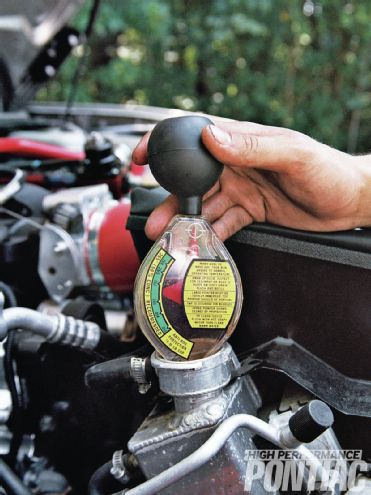
Use a special hydrometer cali- brated for ethylene glycol to measure the freezing and boiling point of traditional coolants. An exotic blend of coolant requires an instrument calibrated to that chemistry.
It’s important to understand that the hydrometer is usually calibrated to a coolant temperature of 60 degrees Fahrenheit, and the reading will skew above or below that. Only a temperature-corrected instrument can be employed with hot or cold coolant.
Many check the freeze point with the coolant warmed up; the reading is close but not accurate. Temperature-corrected hydrometers are expensive; there isn’t a need for the Pontiac hobbyist to own one. Use a simple, well-made ambient-temperature-calibrated unit. With the proper 50 percent concentration, the freeze point should be close to minus 34- degrees Fahrenheit, and the boil-over point should be close to 265 degrees.